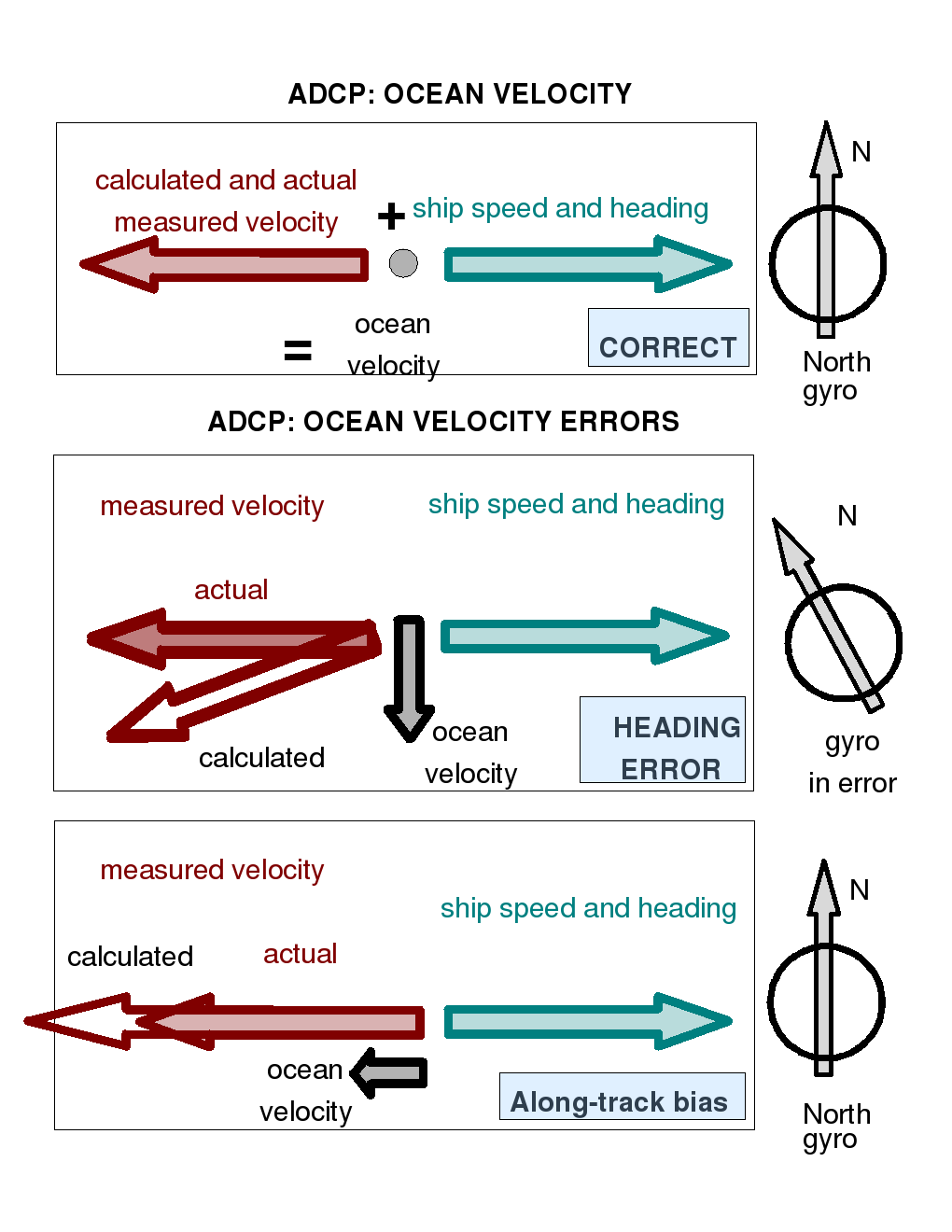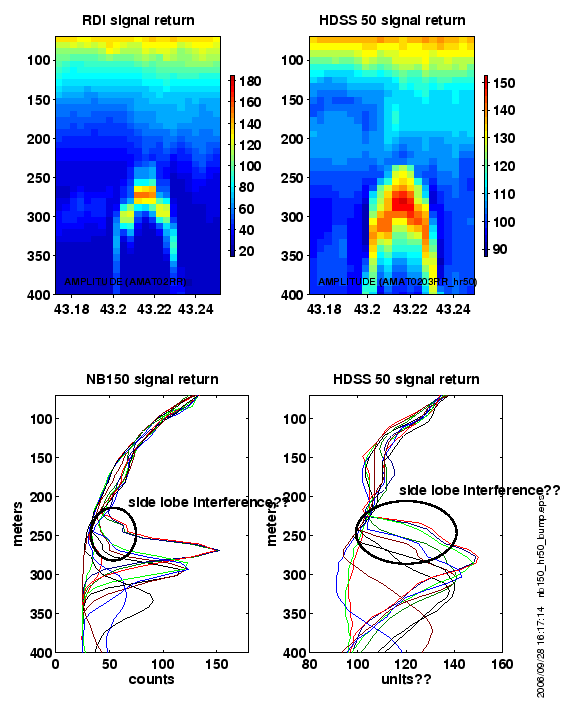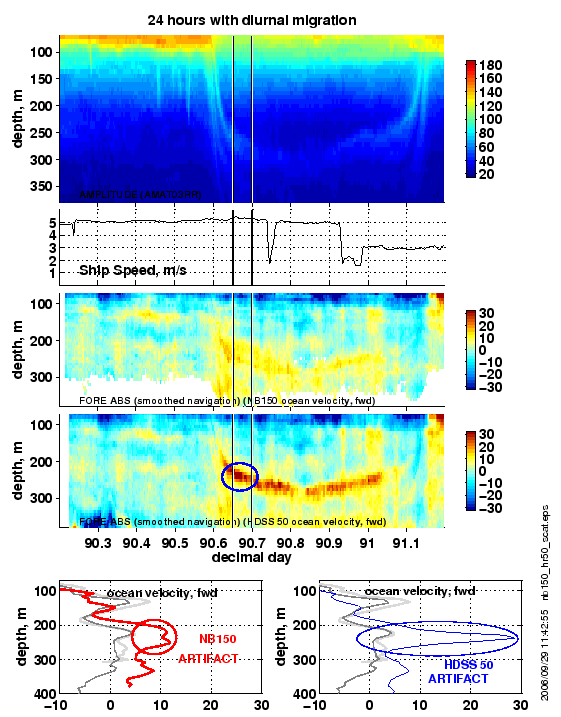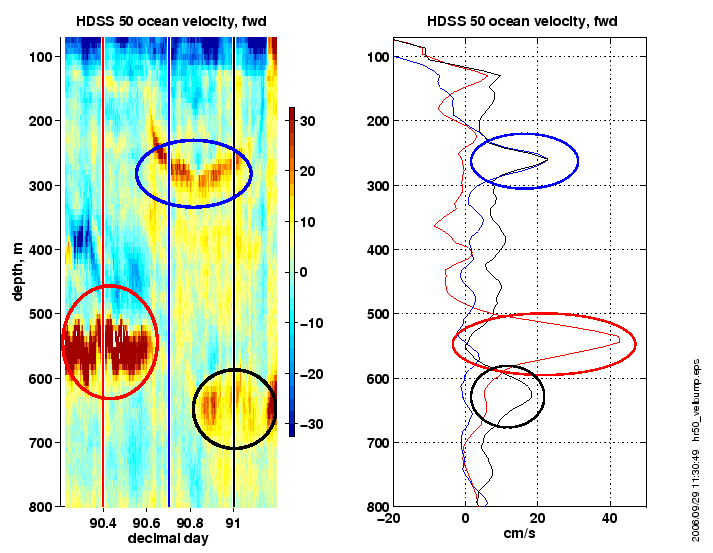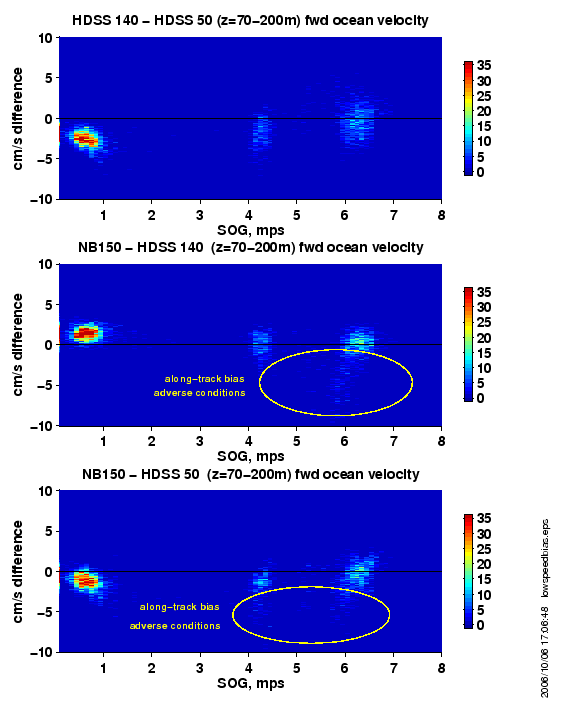Abstract
University of Hawaii ADCP data acquisition and processing software
"UHDAS" has been installed on the Revelle since November 2004,
collecting, processing, and distributing ocean velocities derived from
the R.D.Instruments 150kHz Narrowband ADCP. UHDAS replaces the
DOS-based system provided by the manufacturer and allows for storage
and manipulation of single-ping data. A comparison between the NB150
and HDSS sonars (50kHz and 140kHz) was attempted during a CLIVAR
cruise in January/February 2005, but the HDSS sonars were not
functioning at full capacity.
Recent replacement of two transducers on the HDSS 50kHz system and
repair of one beam (wiring?) in the HDSS 140kHz instrument as well as
partial upgrades to the electronics of both HDSS systems now allow for
a better comparison. The HDSS sonars were designed to maximize
vertical resolution for measuring small-scale shear. With the
exception of the anomalous shear in the 50kHz instrument caused by the
presence of scattering layers, however, shear will not be discussed in
this report. Instead, the emphasis is on measurement of water velocity
relative to the earth.
Comparisons were made using 5-minute averages from all three
instruments. Processing steps included single-ping editing prior to
averaging, heading correction (from gyro to Ashtech heading), and
scale factor and misalignment calibrations. Averages were then edited
for egregious outliers. Comparisons revealed biases of some concern.
At high speeds the 50kHz instrument has very large biases in the
forward direction in the presence of strong scattering layers. These
biases are greater in the 50kHz (e.g. 25cm/s) instrument than in the
NB150 (e.g. 5cm/s) where the profile ranges overlap. Below the NB150
range, strong scattering layers can make even larger biases in the
50kHz (40cm/s). The effect at lower speeds or with weaker scattering
layers is not quantified. This source of bias in the 140kHz HDSS also
has not been quantified because strong scattering layers were not
found within the range of that instrument.
A troublesome characteristic shared with RDI instruments in many
installations is the tendency for profiles in rough weather to
contain significant along-track bias due to noise and/or bubbles. All 3
instruments on the Revelle exhibit this bias. The HDSS 140kHz
instrument also seems to acquire a small bias in shear (few cm/s over
its range) when underway and conditions deteriorate.
At low speeds, both HDSS instruments show small biases (1-2cm/s)
relative to the NB150 and relative to each other. The cause
is unknown.
Any scientist wishing to use the HDSS sonars must decide how much error
they are willing to tolerate in ocean velocities, and how much work
they are willing to do to obtain the final data quality for their purpose.
In addition to the problems noted above, the HDSS data acquisition
system and files have some bugs and annoyances.
NB150 vs/ HDSS: evaluation summary
Cruises used for comparison
Single-ping data were collected from late January to late June, 2006
(see table below). HDSS 140kHz data from the first legs (AMAT02RR and
AMAT03RR) were disregarded because the instrument was improved during
AMAT04RR.
Table: Cruises for comparison
|
Cruise
|
Dates
|
NB150
|
HDSS 140
|
HDSS 50
|
days
|
|
AMAT02RR
|
Jan 25 - Apr 05
|
yes
|
NA
|
yes
|
32
|
|
|
|
|
|
|
|
|
AMAT03RR
|
Apr 7 - Apr 13
|
yes
|
NA
|
yes
|
6
|
|
|
|
|
|
|
|
|
AMAT04RR
|
Apr 19 - May 23
|
yes
|
yes
|
yes
|
35
|
|
|
|
|
|
|
|
|
AMAT06RR
|
June 3 - June 18
|
yes
|
yes
|
yes
|
15
|
ADCP data processing
Data from all three instruments were averaged in 5-minute groups in
earth coordinates, and processed with University of Hawaii's open
source CODAS
ADCP processing code. This processing consists of the following:
-
select group of raw (single-ping) ADCP beam-velocity profiles
-
use beam orientations to convert velocities to ship coordinates
-
use gyro heading to transform velocities to earth coordinates
-
edit out bad velocities (from bubbles, underway bias, etc)
-
average in time (yields a profile of average measured velocity)
-
write the following information to disk,
for subsequent loading into CODAS database:
-
average measured horizontal velocity (E and N)
-
vertical and error velocities
-
average signal strength
-
percent good (from single-ping editing of profile)
-
temperature, position, time, heading (end of profile)
-
load the information into the database
-
edit all averaged profiles, screening for underway bias,
anomalous offsets
-
correct gyro heading to Ashtech heading (more accurate)
-
determine remaining contant angle and scale factor remaining
("watertrack calibration")
-
rotate the measured velocities in the database to account for the
constant angle found
-
multiply all measured velocities by the required scale factor
-
use a slightly smoothed reference layer velocity estimate
based on GPS positions
to generated absolute ocean velocity profiles
Cross-track and Along-track Errors
If the ship's acceleration exceeds a specified threshold, the data
near that time of acceleration is used for a calibration calculation.
This calculation is referred to in CODAS processing as "watertrack"
calibration, to distinguish it from "bottom track" or "reciprocal
track" calibrations.
Two common sources of error in ADCP ocean velocity calculations are
the total angle used to transform beam coordinates to earth
coodinates, and the extent to which the measured velocities are
consistently too small or too large. These errors are
nearly independent,
with the angle error primarily affecting cross-track velocity
component and the scale factor affecting along-track component.
Both angle and scale factor errors are proportional to ship
speed; the table below assumes a ship's speed of 6 m/s.
Even small errors in angle or scale factor make substantial
errors in the velocity estimate, compared to the
typical open ocean velocities (15-40 cm/s). The errors are
particularly bad for transport estimates because they are
independent of depth and persistent in time—they don't
average out.
|
error type
|
error direction
|
ocean velocity error
|
|
angle, 1 deg
|
cross-track
|
10 cm/s
|
|
|
|
|
|
scale, 2%
|
along-track
|
12 cm/s
|
The following figure illustrates the way in which angle and scale
factor errors result in cross-track and along-track errors,
respectively.
Watertrack Calibration
Watertrack calibration assumes that the ocean velocity is the same no
matter what the ship is doing. The approach is to determine what
rotation (near zero) and scale factor (near one) are necessary to
minimize the difference in the ocean velocity determined before and
after the acceleration. Individual estimates are noisy, but if the
heading measurements and ADCP velocities are good then the noise is
random, and it averages out when many estimates can be made.
Watertrack calibration opportunities usually come during bathymetric
cruises, when the ship turns often, or cruises which involve station
work (stopping for a station and starting again yields two
opportunities for calibration).
Watertrack calibrations from AMAT04RR were obtained for all three
instruments with the same reference layer, 75-200m. Results
for the scale factor are:
|
Instrument
|
mean
|
median
|
stddev
|
num pts
|
|
HDSS 140kHz
|
1.004
|
9 1.0030
|
0.0102
|
79
|
|
NB 150kHz
|
0.999
|
0 0.9993
|
0.0069
|
87
|
|
HDSS 50kHz
|
0.999
|
5 0.9992
|
0.0111
|
72
|
Scale factor should be very close to 1.0000 if the speed of sound at
the transducer is accounted for, and if beam geometries are known.
Watertrack calibrations indicate that none of the three instruments
requires an anomalous scale factor.
Bias at high speeds: Vertically localized bias from scattering layers
The beams of Doppler sonars are designed to be narrow so as minimize
returns from directions other than along the beam axis. Returns from
very strong scatterers off the beam axis can still contaminate the
signal, however. For example, the return from the ocean bottom, or
from a strong scattering layer, at 300 m depth, which on average will
have a Doppler shift of zero, will contaminate the along-axis return
from 260-m depth, which will have a Doppler shift proportional to the
ship's speed. Hence the downward-pointing sidelobe of the beams
biases the velocity estimates towards zero.
The Revelle went over a seamount that was in range of the NB150 and
HDSS 50kHz instruments. The signal returns (amplitude on a log scale)
from both are plotted below. We are not sure what units the HDSS
software provides; the values are scaled to have similar magnitudes to
the NB150 for convenience.
The circled "bumps" below show the return from the downward-pointing
sidelobes, and the overall shape of the returns from the bottom
indicate the width of the beam patterns. Although the signal strength
units differ, the shapes indicate that the HDSS 50kHz has surprisingly
strong sidelobes.
This is confirmed by the velocity profiles shown below; the seamount
contaminates the velocity estimates of both instruments starting at
85% of the water depth, but the artifact is much larger for the HDSS
50 than for the NB150.
A graphic example of this effect in the water is provided by the
diurnal migration of various critters. Diurnal migrators swim down
during the day to avoid predation, and swim back up at night to feed.
These migrations are visible in the scattering return from both
instruments. A 24-hour period of data from the HDSS 50kHz and NB150
instruments (where they overlap) is plotted below. The velocity
artifact is obviously larger for the HDSS 50kHz than for the NB150.
The gray lines in the same plots are profiles from nighttime, just
before the migration. In the absence of strong scattering layers, the
two instruments agree well underway in the overlap region.
The NB150 has much shorter range than the HDSS 50kHz, although they
both have the same resolution. The following figure shows the same
time period and the same variable (ocean velocity in the forward
direction) for the HDSS 50kHz for its full range. The bump in
velocity discussed above is centered around 250m (circled in blue).
Below the range of the NB150, at 550m and 620m, are additional
scattering layers with corresponding artifacts in HDSS 50kHz ocean
velocity (in the forward direction). These are circled in red and
black, below.
Bias at Low Speeds
The scale factor correction based on watertrack calibration removes
the velocity error proportional to ship's speed, but the watertrack
calibration is insensitive to low-speed bias. To check for the
latter, ocean velocity estimates in the along-track (forward)
direction from the HDSS instruments and the NB150 were compared to
each other as a function of ship's speed. To avoid biases caused by
scattering layers, the comparison was made using a reference layer
that is generally not affected by persistent scattering layers
(100-150m).
Since ocean velocity is calculated as
u_ocean = u_ship + u_measured,
if the measured velocity (which is negative in the along-track direction)
is biased towards zero, this results in a
an ocean-velocity bias that is positive in the along-track direction.
These velocities come from calibrated datasets, and the calibrations
are designed to account for speed-dependent angle and scale factor
errors. Therefore, at high ship speeds, the differences are small.
However, at low ship speeds, the NB150 ocean speeds exceed the HSSS
140kHz ocean speeds in the forward direction, indicating that the
NB150 measured velocities are biased towards zero relative to the HDSS
140kHz. The opposite is true for the HDSS 50kHz instrument: its
measured velocities are biased towards zero compared to the NB150.
The third panel compares the two HDSS instruments, in which there is a
2-3cm/s bias towards zero in the 50kHz instrument compared the the
140kHz instrument.
There are similar differences in the cross-track direction,
so the bias does not seem to be simply a change in scale
factor at low speeds. It is also unclear whether whatever
is causing the low-speed bias operates only at low speeds;
its effect at cruising speed, if any, would be
indistinguishable from other factors in the watertrack
calibration procedure.
The bias in the 50 kHz instrument has been present since 2003 and
was seen in a comparison between the NB150 and the HDSS 50khz
instrument during HOT cruise #149. The fact that the bias
is largest in the comparison between the two HDSS
instruments means that there is a real bias in at least one
of those instruments—this is not just an NB150 problem.
Illustrative summary of biases
All three instruments can have biases in the along-track direction
when conditions get sufficiently rough. Bubbles that block the
outgoing or incoming signal result in a shorter profiles, often biased
towards zero beam velocity. This creates a bias towards zero in
measured velocity in ship's coordinates in the along-track direction.
Improved single-ping editing can help weed out the bad pings before
averaging.
However, after single-ping editing and visual editing of averaged
profiles, there were still along-track differences between HDSS and
NB150 instruments. The following four figures show the differences
between NB150 and HDSS instruments in a time series of 70-200m
reference layer averages of ocean velocity in the ship's forward
direction. The first figure is repeated 3 more times, with different
errors annotated.
reference layer time series

This figure and the following annotated versions, have five lines:
- NB150 - HDSS 50kHz difference, cm/s (blue)
- NB150 - HDSS 140kHz difference, cm/s (red)
- ship speed, m/s (gray)
- Percent good (divided by 10) for HDSS 140kHz (green dots)
- Percent good (divided by 10) for HDSS 50kHz (black dots)
This first figure is repeated 3 more times, with different errors
annotated.
low speed bias
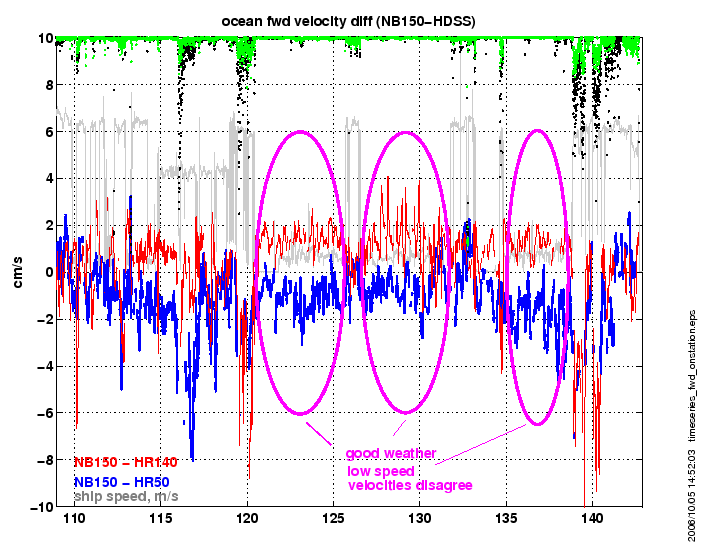
Three annotated regions show the velocity differences hovering around
1-2cm/s for NB150-HDSS 140, and around -1-2cm/s for NB150 - HDSS 50.
Conditions during acquisition were good as indicated by the fact that
Percent Good (black and green dots) are around 100 (i.e. shown as
values around 10, because Percent Good was scaled by 10).
good agreement underway, in good weather

Three annotated regions show the velocity differences closer to zero
for underway periods compared to neighboring on-station periods.
Conditions during acquisition were good as indicated by the fact that
Percent Good (black and green dots) are around 90-100 (i.e. shown as
values around 9-10, because PG was scaled by 10). It is common for
Percent Good to decrease slightly when underway.
underway bias in bad wather
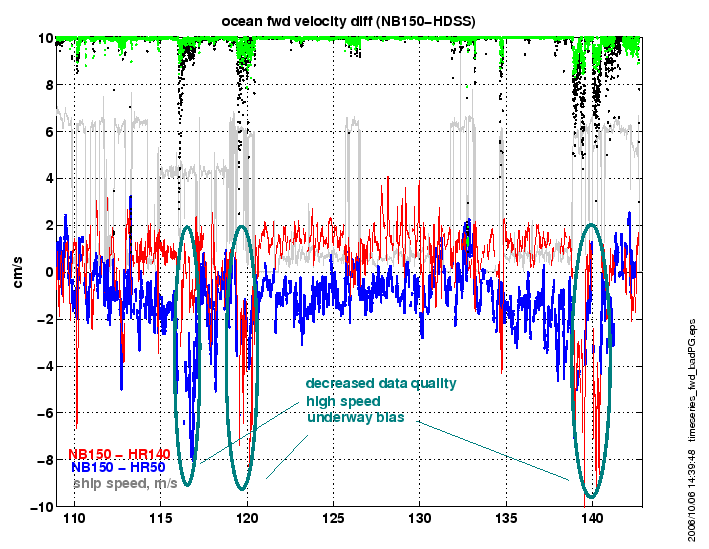
Three annotated regions show the velocity differences in which the
HDSS ocean velocities were biased in the direction of travel,
resulting in NB-HDSS being negative by 4-10cm/s. The weather during these
periods was worse, as seen by the clouds of decending black and green dots.
The last figure illustrates that the HDSS 140 can have a larger shear
in the forward direction compared to the HDSS 50, when any of the
following conditions are met: underway, at the bottom of the profile,
and as 140kHz profile quality (average Percent Good of the 70-200m
reference layer) decreases. This same pattern is repeated when
compared to the NB150 (not shown). There was no such difference
between the NB150 and the HDSS 50kHz in their overlap region.
However, because the HDSS 50kHz should have generally high quality
data in the upper 200m but profiles much deeper than the NB150, we
cannot look for shear bias in the 50kHz at the bottom of the profile
similar to that found in the 140kHz.

Files and Data Access
Data are currently gathered on two Macintosh OS 9 machines, one per
instrument. One newer OSX machine provides the interface between the
OS 9 data-logging machines and the rest of the world. The OSX
computer contains the Matlab code provided to read the single-ping
beam-velocity data files that are saved to disk, the data files, some
documentation, and a few other products (30-second averages stored as
matlab files, and some figures).
One must specifically request single-ping data. Standard practice
evidently results in smaller data files consisting of data averaged in
beam coordinates. No attempt has been made to assess those
files, but in general velocity estimates from any moving
platform like a ship should be vector-averaged in
geographical coordinates, not simply averaged in beam or
platform coordinates.
Some improvements have been made to variable names and file
conventions, but until the complete switch to Mac OS X for data
acquisition, the present code will result in the following annoyances:
-
one must check for a vertical offset between instruments
-
ascii sorting of filenames does not match order of acquisition
-
filenames contain square brackets (bad for command-line users)
-
west longitudes are positive (are east longitudes negative??)
-
longitudes are parsed incorrectly (minutes recorded to only 3
decimal places vs/ 4 for latitude)
-
the reference year for acquisition dates is 2003
-
ashtech pitch and roll are recorded incorrectly (always positive)
Summary
-
The HDSS 50kHz instrument seems to have surprisingly fat beams, resulting in
large localized biases in the presence of strong scattering layers.
-
The HDSS 140kHz instrument did not penetrate deep enough to run into
the bottom or any strong scattering layers during the
two comparison cruises. Therefore its beam characteristics and corresponding
scattering layer artifacts could not be evaluated.
-
Both HDSS instruments and the NB150 are affected by biases in the forward
direction under adverse conditions
-
The HDSS 140 shows a bias in forward shear underway under
variably adverse conditions compared to both the NB150 and HDSS50.
The HDSS 140 bias in the forward direction seems to be a continuum,
not occuring only under extreme conditions. Improved single-ping editing
may improve this aspect in averaged profiles.
-
There are unexplained biases of a few cm/s in both HDSS instruments at
low speeds.


